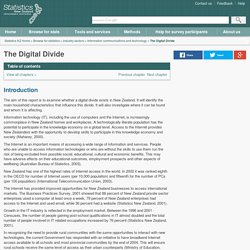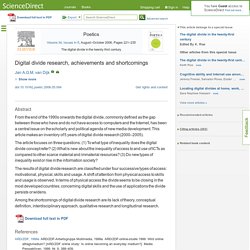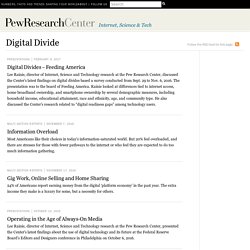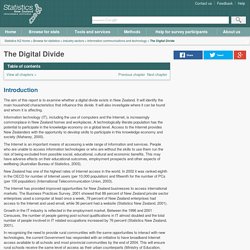

CheapEnoughWD_Hilbert_pre-print. GIUS2012-GlobalData-Table-20121120_0. Google Translate. Access to information: bridging the digital divide in Africa. With all the excitement about the role of technology in contributing to social change and improved development outcomes across Africa, it is easy to forget that only 7% of the continent's inhabitants are online.

While mobile phone usage is widespread at 72%, this masks regional differences. Eritrea's mobile penetration rate, for example, is just 5%. The internet's limited reach is compounded further because the language of the web is English and mobile connectivity is limited as only 18% of Africa's mobiles are smartphones. Organisations need to address these barriers and some are beginning to do so in innovative ways. They are combining low and high-tech approaches to ensure that citizens are able to access critical information that can help improve their lives. In Liberia, impressive reforms have resulted in an explosion in the availability of government information. Other organisations should consider how to improve accountability mechanisms by adopting similar approaches. 19331680903109402# Internet-Skills-and-the-Digital-Divide.
West_internet-access. WSIS: Declaration of Principles. Wh_digital_divide_issue_brief. The Digital Divide. The aim of this report is to examine whether a digital divide exists in New Zealand.

It will identify the main household characteristics that influence this divide. It will also investigate where it can be found and whom it is affecting. Information technology (IT), including the use of computers and the Internet, is increasingly commonplace in New Zealand homes and workplaces. A technologically literate population has the potential to participate in the knowledge economy on a global level. Access to the Internet provides New Zealanders with the opportunity to develop skills to participate in this knowledge economy and society (Maharey, 2000).
Home « Inveneo. Powering a new generation of learning. 185-220.pdf. Digital divide research, achievements and shortcomings. Volume 34, Issues 4–5, August–October 2006, Pages 221–235 The digital divide in the twenty-first century Edited By K.

Roe Abstract From the end of the 1990s onwards the digital divide, commonly defined as the gap between those who have and do not have access to computers and the Internet, has been a central issue on the scholarly and political agenda of new media development. The article focuses on three questions. (1) To what type of inequality does the digital divide concept refer?
The results of digital divide research are classified under four successive types of access: motivational, physical, skills and usage. Among the shortcomings of digital divide research are its lack of theory, conceptual definition, interdisciplinary approach, qualitative research and longitudinal research. Howard et al., 2001P. Rojas et al., 2004V. Vitae Jan A.G.M. van Dijk is professor of communication science at the University of Twente, the Netherlands, Department of Communication. Huawei-economist_redefining-the-digital-divide_en_201311. West_internet-access. ONLINE-WIPNZ2007_20137_7-0702a. Digital Divide. Digital Divides – Feeding America Lee Rainie, director of Internet, Science and Technology research at the Pew Research Center, discussed the Center’s latest findings on digital divides based a survey conducted from Sept. 29 to Nov. 6, 2016.

The presentation was to the board of Feeding America. Rainie looked at differences tied to internet access, home broadband ownership, and smartphone ownership by several demographic measures, including household income, educational attainment, race and ethnicity, age, and community type. He also discussed the Center’s research related to “digital readiness gaps” among technology users. Information Overload Most Americans like their choices in today’s information-saturated world. Gig Work, Online Selling and Home Sharing 24% of Americans report earning money from the digital ‘platform economy’ in the past year. Operating in the Age of Always-On Media Digital Readiness Gaps Book Reading 2016.
The Digital Divide. The aim of this report is to examine whether a digital divide exists in New Zealand.

It will identify the main household characteristics that influence this divide. It will also investigate where it can be found and whom it is affecting. Information technology (IT), including the use of computers and the Internet, is increasingly commonplace in New Zealand homes and workplaces. A technologically literate population has the potential to participate in the knowledge economy on a global level. Access to the Internet provides New Zealanders with the opportunity to develop skills to participate in this knowledge economy and society (Maharey, 2000). Digcitizen.